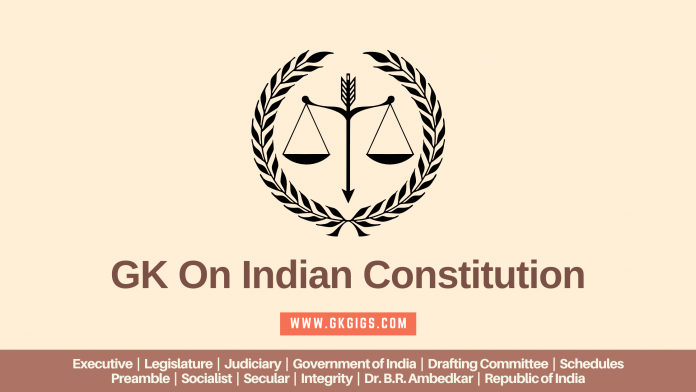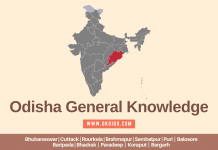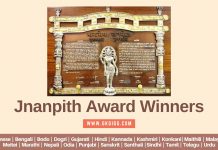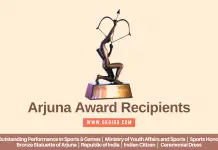
Last Updated: 22 December 2023
Bhāratīya Saṃvidhāna or The Constitution of India is the governing law of India.
It is very important to know the law and order of our country for personal knowledge as well as for competitive exams. In this article, you will find all the useful questions and answers that you’re looking for.
Page Contents
Important Facts About The Indian Constitution
- The Indian Constitution is the longest-composed Constitution on the planet.
- The title of Father of the Indian Constitution is given to Dr. B.R. Ambedkar.
- The Constitution of India became effective on 26 January 1950.
- The Original 1950 Constitution Text is preserved in a helium-filled case at the Parliament House in New Delhi.
- Indian Parliament cannot override the Constitution.
Read the Indian Constitution GK Questions and Answers as there are chances for repeated questions in competitive exams. The table of Schedules of India is also included.
The official Constitution of India PDF download link is given at the end.
Indian Constitution GK
Answer:
a) Executive
b) Legislature
c) Judiciary
Answer: Government of India Act 1935
Answer: 60 Countries
Answer: 6 December 1946
Answer: Objective Resolution
Answer: 22 July 1947
Answer: Dr. B.R. Ambedkar
Answer: G. V. Mavlankar
Answer: 2 years 11 months and 18 days
Answer: ₹6.3 crore
Answer: Socialist, Secular, and Integrity
Answer: Portuguese
Answer: 26 January 1950
Answer: 12 Schedules
Answer:
1) Financial Standing Committees (FSC)
2) Department Related Standing Committees (DRSC)
3) Others Standing Committees (OSC)
Answer:
1) Public Accounts Committee
2) Estimates Committee
3) Public Undertakings Committee
Answer: The Estimates Committee
Answer: The Speaker
Answer: Article 338
Answer: Hiralal Kania (26 January 1950)
Related: Quiz On The Constitution Of India (Important Objective Questions)
Answer: All the adult citizens of the village above 18 years
Answer: The Lok Sabha (A.K.A House of the People)
Answer: The Rajya Sabha (A.K.A Council of States)
Answer: 14th
Answer: Official Languages of the Republic of India
Answer: 8 Schedules
Answer: Third Schedule
Answer:
1) Andhra Pradesh
2) Bihar
3) Karnataka
4) Maharashtra
5) Telangana
6) Uttar Pradesh
Answer: Constitution Act, 1987
Explanation: Arunachal Pradesh was granted Statehood with the 55th Amendment Constitution Act, 1987 and became the 24th State of the Indian Union.
Answer:
1) Right to Equality
2) Right Against Exploitation
3) Right to Freedom
4) Cultural and Educational Rights
5) Right to Constitutional Remedies
6) Right to Freedom of Religion
Related: List Of All Prime Ministers Of India With Photo (1947 to 2024)
Answer: The President of India
Answer: Legislative Assembly
Answer: Bhāratīya Saṃvidhāna (भारतीय संविधान )
Answer: Rajya Sabha and Lok Sabha
Answer: Prime Minister Of India
Answer: 104 (Last Amended 25th January 2020)
Answer: Sir Benegal Narsing Rau
Answer: Surendra Nath Mukherjee
Answer: The President of India
Answer: Dr. B.R. Ambedkar
Related: Bharat Ratna Award List In India (1954 – 2024)
Answer: Prime Minister of India
Answer: Lok sabha Secretariat
Answer: Parliament by Law
Answer: Mini Constitution
Answer: Supreme Court, High Courts, and District Courts
Answer: 12 (Twelve)
Answer: Chief Justice of India
Answer: Article 14-18
Answer: 5 July 1947
Explanation: approved on 18 July 1947
Answer: P. V. Narsimha Rao
Related: Ladakh Static GK Questions And Answers (Union Territory)
Schedules Of The Indian Constitution
| No. | Schedule | Description |
|---|---|---|
| 1 | First Schedule | a) Lists of India’s states and territories b) Changes in their borders c) The laws that are used for making that change |
| 2 | Second Schedule | List of the Provisions and salaries for: a) The President b) The Governors of States c) The Chairman and the Deputy Chairman of the Rajya Sabha d) The Speaker and the Deputy Speaker of the Lok Sabha e) The Speaker and the Deputy Speaker of the Legislative Assembly in the states f) The Chairman and the Deputy Chairman of the Legislative Council in the states g) The Judges of the Supreme Court and High Court h) The Comptroller and Auditor-General of India |
| 3 | Third Schedule | Forms of Oaths and Affirmations |
| 4 | Fourth Schedule | Detail allocation of seats in the Rajya Sabha by state or union territory. |
| 5 | Fifth Schedule | Provisions for the Administration and control of Scheduled Tribes and Scheduled Areas |
| 6 | Sixth Schedule | Provisions were made for the administration of tribal areas in Assam, Meghalaya, Tripura, and Mizoram |
| 7 | Seventh Schedule | The Central Government, State, and Concurrent lists of responsibilities |
| 8 | Eighth Schedule | Official Languages |
| 9 | Ninth Schedule | Validation of certain Acts and Regulations |
| 10 | Tenth Schedule | Anti-defection provisions for members of Parliament and State Legislatures. |
| 11 | Eleventh Schedule | Panchayat Raj (A.K.A Rural Local Government) |
| 12 | Twelfth Schedule | Municipalities (A.K.A Urban Local Government) |
51. From Which country was The idea of ”Concurrent List” in the Indian Constitution borrowed?
Answer: Australia
52. Which Country has No Written Constitution?
Answer: Saudi Arabia
53. Which right was not taken from the British Constitution in the Indian Constitution?
Answer: Fundamental Rights
54. What is the true meaning of “Secular”?
Answer: All religions are equal before the government
55. Which Article defines the Right to Religious Freedom?
Answer: Article 25-28
56. Who said that the preamble of the Indian Constitution is “The Keynote of the Constitution”?
Answer: Ernest Barker (Political scientist)
57. Which Article is for the Protection of the interests of Minorities?
Answer: Article 29
58. What is Article 17?
Answer: Abolition of Untouchability
59. Write the three main reasons behind the failure of the Cripps’ Mission?
Answer:
1) Gandhi’s resistance drove the Indian National Congress to dismiss the British offer.
2) Cripps’ adjustment of the first British offer, which accommodated no genuine exchange of power.
3) The behind-the-scenes endeavors of the Viceroy and Secretary of State for India to undermine the mission.
60. Which Articles cannot be suspended during the National Emergency?
Answer: Article 20 and Article 21
Related: List Of Padma Vibhushan Award Recipients (1954-2024)
61. How many Articles are written in the Constitution when it came into effect?
Answer: 395 articles
Explanation: 22 parts and 8 schedules having about 145,000 words.
62. How many Articles were written in the Constitution after the Independence of India?
Answer: 470 Articles (A/O 14 January 2019)
63. How many members signed the Indian Constitution?
Answer: 284 members
64. When was the Constitution of India signed?
Answer: 24 January 1950
65. The maximum number of members in a legislative assembly of a state in India?
Answer: 500
66. Who can remove the Governor of a state from office?
Answer: The President of India
67. When was the First Citizenship Act passed by the parliament?
Answer: 1955
68. An Act that is associated with “Courts can Interpret the Rules and Regulations”?
Answer: Charter Act of 1793
69. Which plan had the scheme to transfer power to the Indians and partition the country?
Answer: Mountbatten Plan
70. What is the meaning of social equality in the Constitution of India?
Answer: Equal opportunities for all sections of the societies
Related: Facts About Central Vista Redevelopment Project (2020-2024)
71. The language of the Preamble of the Indian Constitution is taken from which country?
Answer: Australia
72. Which Article is related to Equality before the law?
Answer: Article 14
73. 53rd Amendment of the Indian Constitution 1986 made full statehood for?
Answer: Mizoram
74. Where is the concept of a Welfare State found in the Indian Constitution?
Answer: The Directive Principles of State Policy
75. Which states have been under President’s rule for a long period?
Answer: Punjab (More than 3000 Days/10 Years)
76. Article 22 of the Constitution of India?
Answer: Protection against arrest and detention in certain cases
77. Which article is related to the Right To Education?
Answer: Article 21A
78. Which article is related to the Right to Information Act (RTI)?
Answer: Article 19 (Right to Freedom of Speech and Expression)
79. 5 Types of Writs in the Indian Constitution?
Answer:
1) Habeas Corpus
2) Mandamus
3) Certiorari
4) Prohibition
5) Quo-Warranto
80. Articles 324-329 of the Indian Constitution deal with which topic?
Answer: Election
Related: Council Of Ministers Of India (All 28 Indian States)
81. How many parts are there in the Indian Constitution?
Answer: 22
82. Who was elected as the Temporary President of the Constituent Assembly?
Answer: Sachchidananda Sinha
83. Who was elected the Permanent President of the Constituent Assembly?
Answer: Dr. Rajendra Prasad
84. What is the Tenth Schedule?
Answer: Anti Defection Act
85. Which Act allowed Christian Missionaries to spread their religion in India?
Answer: Charter Act of 1813
86. Which Article is related to the Special Address by the president of India?
Answer: Article 87
87. First President of India?
Answer: Rajendra Prasad
88. From which Fund is the salary of the President of India taken?
Answer: Consolidated Fund
89. Who gives recognition to the Political Parties in India?
Answer: The Election Commission of India
90. Which Act divided legislative powers between Provinces and the Centre?
Answer: Government of India Act, 1935
Related: GK Facts About Indian Prime Ministers (1947-2024)
91. After how many years has the Finance Commission been appointed?
Answer: Five Years
92. How many Maximum numbers of Members can Rajya Sabha hold?
Answer: 238
93. Articles 5-11 of the Indian Constitution deal with which topic?
Answer: Citizenship of India
94. Part 3 of the Indian Constitution is related to which Rights?
Answer: Fundamental Rights
95. Who enjoys the Legislative Powers?
Answer: The Parliament
96. What is the term of the Members of Rajya Sabha?
Answer: 6 Years
97. Who decides whether the introduced bill is a Money Bill or not?
Answer: Speaker of the Lok Sabha
98. What is the term of the President of India?
Answer: 5 Years
99. Who advises the Government of India in legal matters?
Answer: The Attorney General of India
100. The total number of seats in Lok Sabha?
Answer: 543
Related: Council Of Ministers Of India (All 28 Indian States)
101. The total number of seats in Rajya Sabha?
Answer: 250
102. Which court has the highest Jurisdiction?
Answer: Gauhati High Court
103. Which Article describes the election of the President of India?
Answer: Article 55
104. When was the first General Election held in India?
Answer: 1951–52 (held from 25 October 1951 to 21 February 1952)
105. Who holds the record for the highest victory margin in Lok Sabha Election?
Answer: Anil Basu
106. Which is the largest union territory of India?
Answer: Ladakh (59,146 km²)
107. Supreme Court Judges retire at what age?
Answer: 65 Years
108. Who is the ex-officio Chairman of the Rajya Sabha?
Answer: The Vice President of India
109. Which Indian state has the highest number of Members of the Legislative Assembly (MLA)?
Answer: Uttar Pradesh (404 Members)
110. Who has the longest tenure as the Speaker of Lok Sabha?
Answer: Sumitra Mahajan
| Read More |
- New Union Cabinet Ministers Of India List With PDF (2024)
- A Complete List Of Indian States: Nicknames, Area, Richest, Largest
- 100+ General Knowledge Questions On Northeast India
- Attorney General Of India (2024 List Updated)
- 110+ GK Questions And Answers On Indian Railway (RRB Exam)













Very good for training students.